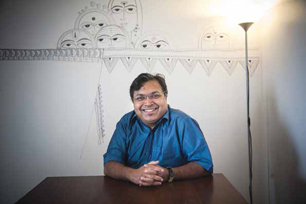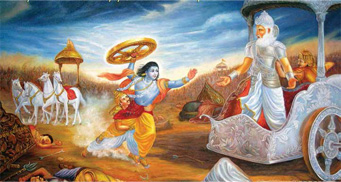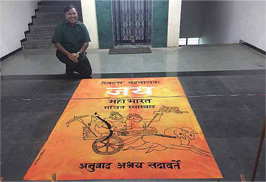
I want to begin with a story, for the best way to tell you about the Mahabharata is to narrate a story.
On the 18th day of the war, Duryodhan suddenly realises that he has lost all his brothers, generals everybody has been defeated, destroyed, killed. The Pandavas are victorious, so he decides to run away from the battlefield. He runs towards the river, which is on the edge of the Kurukshetra. It has turned into a river of blood, but he thinks that if he goes to the other side of this river, he will be safe and he will stay alive. Suddenly he is consumed by the fear of death. He jumps into the river but he is so scared, that his legs are paralysed and he feels that he is going to drown in the river of blood. However, luckily, he sees a tree trunk and he holds on to it. By holding the tree trunk, he moves to the other side of the river.
When he reaches the other side, he suddenly realises that in his fear, the log of wood which he was holding was the body of his most beloved son. It was his dead son that was taking the frightened father to the other side, to save him. Duryodhan looks at the dead son and starts to cry, and he realises the horror he has inflicted on the world, all over a piece of land. He decides he should not run away but return to the battlefield and meet his inevitable death.
You won’t find this story in the critical edition of the Mahabharata. You won’t find it in any Sanskrit literature. You will find in the Odiya version of the Mahabharata. Is this the correct story? Or is that the correct story? Which story is the correct story? That is a very difficult thing to decide. If something is written in Sanskrit, does it become correct? If it’s written in Marathi, is it correct? This is the question you ask when you discuss Mahabharata because Mahabharata is a parampara.
Asking the origin of Mahabharata is like trying to find the origin of the river. A river has many tributaries and many branches. You don’t know when a river begins and when it ends. It is very difficult to decide which the starting point is. A tree for example. What point of the tree is the starting point and what point is the ending point of the tree? Is it the root, leaf, fruit or flower?

Asking the origin of Mahabharata is like trying to find the origin of the river. A river has many tributaries and many branches. You don’t know when a river begins and when it ends. It is very difficult to decide which the starting point is. A tree for example. What point of the tree is the starting point and what point is the ending point of the tree? Is it the root, leaf, fruit or flower? Mahabharata is something like that-there are many fruits, flowers, leaves, trees…there are roots in many languages. We have to appreciate the vast body of literature when we try to understand Mahabharata and that is the way the Indian thought has always been. We don’t believe in singularity, we believe in plurality. Everything in nature is diverse; many stories of Mahabharata from different traditions have come and bear such diversity.
But how do you decide what defines the Mahabharata? Whenever there are battles, we assume it is the Mahabharata. That is the nature of storytelling; we automatically assume there is a hero, a villain and there is a victim-this design of storytelling is not Indian. It’s Greek, and we have to be very careful about this - because the earliest translators of Mahabharata were not Indian-they were Americans and Europeans. They assumed that Indian pastors followed the Greek structure and so they constructed heroes, villains and victims, when none of our shastraas talk about heroes, villains or victims.
Our shastraas talk about human beings, flawed human beings. Arjun is a human being, Bheem is a human being-they are struggling with humanity. Only when you see it as the story of human beings who are fighting for what is considered theirs, then you understand the Mahabharata. But what makes it special is (that) there will be a character who is identified as Bhagwan. But you cannot constrict this God because when you say God your mind immediately goes to Judeo-the Christian version of God. Krishna in the Mahabharata is the Bhagwan. That patra changes everything because every other character other than him, has incomplete knowledge. So everybody else has only a slice of the whole reality. But Bhagwan is someone who knows all the slices; he knows everything. He sees every side. And therefore, when he takes a side, it is not because it is the right side or the wrong side-this Euro- American approach destroys the understanding of the scriptures.
Incomplete knowledge exists on both the Kauravas side as well as the Pandavas side. All of us also have incomplete knowledge - that makes us human. We function, we take decisions on the basis of incomplete knowledge and we have to be aware of it. The only one who has complete knowledge is perhaps a theoretical idea called Krishna
Both Ramayana and Mahabharata are full of human characters who listen and don’t listen. Amongst the Pandavas there is a boy called Abhimanyu, who knows how to enter the Chakravyuh but does not know how to come out of it because of incomplete knowledge; still goes to battle and dies. (Among the) Kauravas, there is another warrior who knows how to shoot the brahmastra but does not know how to pull it back due to incomplete knowledge. He shoots the brahmastra and is cursed.
Incomplete knowledge exists on both the Kauravas side as well as the Pandavas side. All of us also have incomplete knowledge, that makes us human. We function, we take decisions on the basis of incomplete knowledge and we have to be aware of it. The only one who has complete knowledge is perhaps a theoretical idea called Krishna. He sees everything I don’t, and so the conversations in the Mahabharata are between someone who has incomplete knowledge and someone with complete knowledge. To make it simple, it is a conversation between people who know something and (someone) who knows a little bit more. How does a teacher deal with a student who knows very little but arrogantly believes he knows everything? Usually people with very strong opinions have very less knowledge - you find them on television shows, on Twitter and on Facebook. They are continuously having opinions as if they are shaastris and the actual shaastris are stunned into silence by their bravery. And that’s what is happening around the world-everybody is making declarations, passing policies, so are they Abhimanyu or Ashvathama-that you decide. One will be killed, the other will be cursed. And Krishna will watch and smile. When you understand this structure you will realise how different it is from a mere story comprising hero, victim and villain of the Greeks.
The Mahabharata is full of affection. Krishna is saying both sides are my children-I love the Kauravas but the difference is that they don’t listen, Pandavas listen, though that doesn’t make them smart. Ask yourself a simple question-in the Mahabharata, where is the servant class? There are Brahmins, Rishis, Rajanyas, soldiers, rich people and educated people. Where is the servant? Where is the cook, where is the massagewala…where are the servants?

There is one servant, Sutta, the charioteer, who is treated horribly and then you realise why in the Mahabharata there is agyantvaas (incognito sojourn) and why all the Pandavas had to spend five years thus. Yudhistir took the form of a gambling companion, Bheem, the form of a cook, Arjun had to take the form of a eunuch dancer, Nakul, a groom in the stables and Sahadev had to take care of horses-basically all had to be servile-naukar. Draupadi, the great queen, had to be sairandhri, the hair dresser. And then, you realise what it means. Bheem cooked food and served others before he could eat. This man who was considered to be always hungry had to first cook and serve others before he did so. Why is this story told? Why has somebody included the story in the Mahabharata? I don’t think it is a part of the critical edition. Doesn’t matter, but you suddenly see: the King’s nose is put to the ground. Yudhistir the king is slapped by Virat (because powerful people slap their servants); Draupadi is publicly humiliated by Kichaka-she is told to take the wine glass and give it to his brother though she knows she is going to be sexually abused. Arjun the stud who has so many wives has to spend one year in the women’s quarter without his genitals and to explore what it means to be a woman, somewhat, and be vulnerable to the sexual innuendos the men pass at you. Nakul and Sahadev are anyway invisible. More invisible.
When you start thinking and you realise that Krishna Bhagwan is staring at the Raja, what it means (is that) when you are in power, you can’t keep lying to the people who serve you. But you don’t tell the story like this. We are too busy talking about the Yuddhabhoomi and Ranbhoomi…
We want to be heroic, but Mahabharata is about empathy; about how people of position abuse their power. The Rajas have been taught the lesson, be it Yudhistir, Bheem, Arjun, Nakul or Sahadev. We also don’t see those 13 years where a tribal man defeats Arjun and tells him ‘tu raja hoga raaj mahal main’ (you may be king in your palace). It has to be compared with the story of Eklavya. Bheem was shown humility by Hanuman. The Pandavas take water without entitlement, Yaksha kills them. We are never told about the Mahabharata like this; we are too obsessed with war, we are too obsessed with its drama of great battlefields, brahmastra and so on. Useless questions because we don’t want to read the psychology; we don’t want to deal with hierarchy, power.
We want to be heroic, but Mahabharata is about empathy; about how people of position abuse their power. The Rajas have been taught the lesson, be it Yudhistir, Bheem, Arjun, Nakul or Sahadev. We also don’t see those 13 years where a tribal man defeats Arjun and tells him ‘tu raja hoga raaj mahal main’ (you may be king in your palace). It has to be compared with the story of Eklavya
The Mahabharata talks about these feelings - it is not about valour’s heroic narrative which was loved by the Americans and Europeans; it is the Indian story-it is about love and empathy, sahanubhuti, aatmiyataa. We must not valorise violence, as, in the end, blood will flow; such details are never given in television serials. We would like to think that Krishna gave a motivational speech, Arjun went to war, killed the Kauravas and became king. This is a complete misreading of the Mahabharata. Krishna tells something to Arjun but in the end he said that jo karna hain kar, karke tujhe hi bhugatna hain (do what you want to do; in the end it is you who has to suffer). When his children die, Krishna says, well, collateral damage, and at the end of the Mahabharata war Arjun comes back-and this part nobody tells us-and asks Krishna to give the summary of his narration of the war. This is Anugita. To which Krishna says. “I don’t remember anything; at that time I was in another state of yog.’’ But we are not told such details because you want to reduce the story into a tension filled drama. You have to focus on emotions and when we focus on emotions, we will understand it is our desire for power and failure to understand what it means to be powerless.
by Devdutt Pattanaik